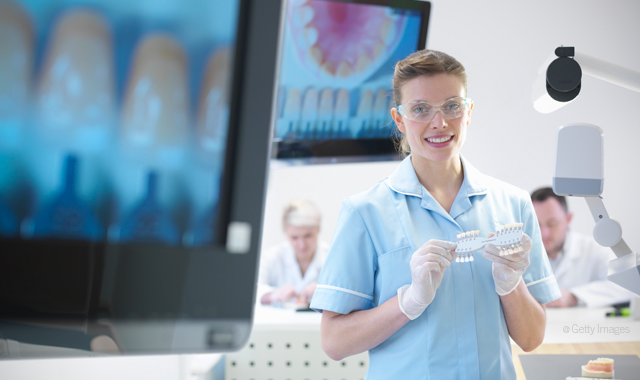How the digital workflow will enhance communication and reliability
Innovations in technology are changing the collaboration between the lab and the doctor.

With innovations in technology for CAD/CAM dental solutions, the collaboration between the lab and the clinician is easier than ever. But how will these advances change the usual workflow between lab and clinician?
We talk with DENTSPLY Sirona’s Kassandra Braun, Marketing Manager, Laboratory CAD/CAM and Prosthetics. She shares her insight on how productivity, communication and reliability improve with enhancements in digital dental solutions for both lab and doctor.
What were some of the challenges dental labs struggled with in the past and why?
Kassandra Braun: There are several major challenges to an analog solution for dental restorations. For one, analog restorations take longer to make. Over time, we’re seeing fewer dental laboratories nationwide. At the same time, patients require more restorations. This means that each laboratory needs to produce more restorations to meet the demand. There are great opportunities in this for labs that are looking to grow by increasing their productivity. Workforce specialization can be another challenge. It is becoming ever more difficult to hire trained waxers and ceramists. These two challenges combine to make it difficult for labs using only analog techniques to compete in the crown and bridge market.
Related article: How 3D printing streamlines your workflow
How have dental digital solutions influenced lab workflow and relationships with practices?
Kassandra Braun: I would say that these solutions have had a major positive influence. Digital solutions have opened the door to faster turnarounds coupled with reliable quality. This, in turn, helps labs compete in a tough market. Designers can use the software to create restorations quickly, as well as use the tools to tailor the restorations to their style. Digital solutions can also allow laboratories to broaden their product offering by including restorations such as surgical guides and fixed hybrid dentures.
The digital workflow opens communication between labs and dentists, and we have seen improvement in relationships.
Up next: The impact of software on the workflow ...
How do features of CEREC® and inLab® influence the workflow and these relationships?
Kassandra Braun: The Sirona Connect portal helps labs and doctors stay on the same page when viewing and discussing cases. The laboratory technician can look at a prep while the patient is in the chair. With the smart watch app, technicians can review cases from anywhere in real time. Using the chat function, technicians and doctors can screenshot cases and discuss them through the portal. Technicians can even provide a design service to doctors through the portal by designing the case and sending it for the doctor to produce on a CEREC milling unit.
Our inLab software helps simplify the lab workflow and speed up turnaround. Recently, the DLOAC hosted a design competition that was open to dental lab technicians. The contest had three timed rounds to design different types of restorations. They were judged on speed, esthetics, occlusion and tooth shape. Zhen Yin, a student at the LA Community College, learned the inLab software that morning and won the $5,000 prize. As part of the competition, he designed an esthetic full-arch upper bridge in less than 10 minutes. With turnaround times like that, a lab can get more cases done faster.
Trending article: Is the future of dentures digital?
How will these technologies evolve, both short- and long-term?
Kassandra Braun: These technologies will continue to evolve to create more synergies. For example, cone beam technology currently integrates with CAD/CAM to allow dentists and labs to create restorations with live functional data. We will see more indications and simplified workflows.
What advice do you have for today’s dental professionals, labs, clinicians, or otherwise regarding digital solutions in the dental practice?
Kassandra Braun: At an inLab Marketing Summit last fall, the keynote speaker was Michael Gerber, author of The E-Myth Revisited. He said that the most important thing a small business owner can do is work on their business and not in their business. The good thing about digital dentistry is that it allows lab owners to do that. If you have not already incorporated digital dentistry into your lab, make that change now, get your training and start getting more done.